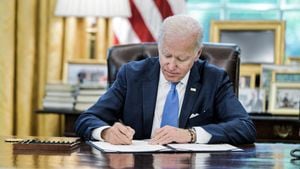Russian President Vladimir Putin has recently reshaped the country's nuclear doctrine, significantly lowering the threshold for the potential use of nuclear weapons. On November 19, 2024, the Kremlin officially announced the updates to its policy, provoking reactions and concerns across the globe. The revised doctrine now permits Russia to launch nuclear strikes not only when faced with existential threats but also as a response to attacks from non-nuclear states, particularly if those states receive support from nuclear powers like the United States.
The timing of this announcement could not be more telling. It coincided with the confirmation of Ukraine's use of U.S.-supplied long-range ATACMS missiles to strike Russian territory for the first time, targeting military sites, including one near the border region of Bryansk. Although Russian air defenses intercepted most of the incoming missiles, the event was seen as provocative, prompting Russia to articulate its new nuclear posture.
Putin's regime has emphasized the need to revise its nuclear strategy to address what it calls the "current political realities," particularly due to increasing Western support for Ukraine. Kremlin spokesperson Dmitry Peskov said the changes were necessary as they now treat attacks on Russia or its ally Belarus as triggers for potential nuclear responses.
William Alberque, an expert on security policies, notes, "The new doctrine claims any nation aligned with nuclear states, or receiving assistance from such nations, can be targeted by Russian nuclear weapons if Russia perceives itself as threatened." This scary expansion of potential nuclear engagement scenarios raises alarms, especially at a time when tensions between Russia and the West are already precarious.
Analysts have pointed out the updated doctrine’s alarming tone, marking it as more aggressive than previous policies. Historically, Russia's nuclear strategy prioritized use only when the state's existence was threatened. But now, the new directive permits nuclear reactions to large-scale conventional attacks, indicating to the world the Kremlin's determination to protect its sovereignty with stark consequences.
Some analysts dismiss these threats as mere intimidation tactics, with U.S. Defense Secretary Lloyd Austin claiming there are no immediate signs of Russia gearing up to use nuclear weapons. "I don’t see a change in their strategic force posture, and we’ll continue to remain vigilant," noted Austin. Similarly, leaders from NATO countries, including British Prime Minister Keir Starmer and French Foreign Minister Jean-Noel Barrot, have spoken out, dismissing Russia's threats as empty rhetoric intended to sow fear.
This modification to nuclear doctrine signals not just potential fallout for Ukraine but for the NATO alliance as well. While it aims to deter Western military aid to Ukraine, which has been ramping up recently, the broader implication is the potential normalization of nuclear rhetoric as part of strategic interactions between nuclear powers.
Reflecting on this escalation, Keir Giles, of the London-based think tank Chatham House, indicated, "Russia's updated doctrine will tie its strategic calculus to any perceived aggression from NATO, especially as Western resources remain committed to supporting Ukraine." He highlighted the seriousness of the situation, noting how Russia falling back on such doctrines constitutes both propaganda and dangerous military governance.
Putin's actions seem intended to consolidate internal support by portraying external threats. This is not merely posturing; the updates are perceived through the lens of Russia's military failings during its campaign against Ukraine. With significant resource allocations made for nuclear modernization and large-scale military exercises meant to demonstrate readiness, Russia is not just talking about their arsenal—they're showing it.
It’s also worth noting the background conditions influencing these changes. Russia is modernizing its nuclear forces significantly, moving away from Soviet-era technology to more recent advancements, heightening its nuclear capabilities. An estimated 95% of Russia's nuclear triad—land, sea, and air-based nuclear capabilities—has been brought to contemporary standards, making nuclear weapons integral to its military strategy.
Alongside this, the sliding scale of arms control globally exacerbates fears of nuclear readiness and escalation. The expiration or suspension of arms control treaties like the New START Treaty, which has already been suspended by Russia, raises questions about each nation’s nuclear intentions.
The repercussions of these developments are still being unpacked by international observers, as many watch for signals of escalation. The increasing normalization of lower-threshold nuclear discourse raises fears of miscalculation. UN Secretary-General António Guterres articulated these concerns, warning of the risks of nuclear threats reaching unprecedented levels.
Despite the clouds of uncertainty and tension looming over the global stage, many experts urge caution against jumping to conclusions about imminent nuclear conflict. Yet, the bottom line is clear; as nations reevaluate their military doctrines and nuclear policies against the backdrop of recent geopolitical dynamics, the stakes are higher than ever.
With the new nuclear doctrine now effectively reshaping Russia's military engagements, it calls to mind the peculiar balance of power among nuclear nations, as well as the need for dialogue and diplomatic engagement to mitigate the risks posed by aggressive military posturing.



